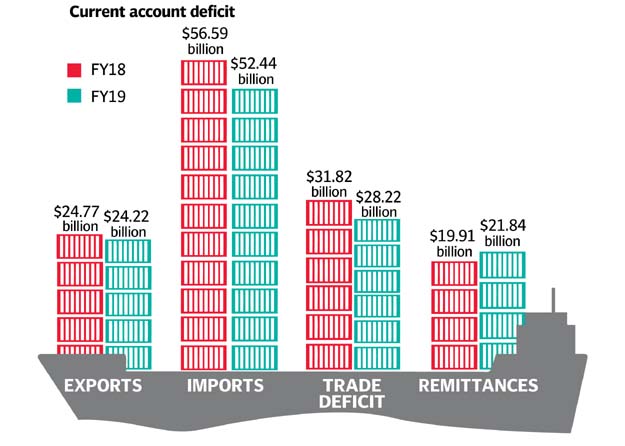Current account deficit contracts 32% to $13.59b
Drop comes mainly due to higher remittances, lower imports in FY19

CREATIVE COMMONS
However, the country failed to achieve the deficit target both in relation to the country’s gross domestic product (GDP) and in total amount.
The deficit came in at 4.8% of GDP worth $283.9 billion compared to the target of 4% for FY19. In terms of total amount, the government had targeted to restrict the deficit to $13.3 billion, according to the Planning Commission.
Pakistan's current account deficit contracts 29.5% to $9.6b
“The current account deficit has dropped but it still remains elevated,” Arif Habib Limited Head of Research Samiullah Tariq said while talking to The Express Tribune.
“This is unsustainable,” he said. “If it remains elevated in the current fiscal year as well, it will keep mounting the pressure on the rupee (against the dollar).”
The deficit beat the target mainly due to the disappointing export of goods, which slipped to $24.21 billion against expectation for around $28 billion, after the central bank let the rupee depreciate 32% to Rs160.05 against the US dollar in FY19.
In remarks made in the past few days, State Bank of Pakistan (SBP) Governor Reza Baqir said depreciation of the rupee and hike in key interest rate had helped in contraction of twin deficits - the current account and fiscal deficits - significantly.
“The current account deficit has dropped to $1 billion a month (in FY19) compared to $2 billion a month last year,” he said. Exports have improved in volumes but not in value. “Textile exports have (alone) increased around 30%,” he said.

“The current account deficit has remained in the economy due to increase in international petroleum oil prices in recent months,” he added. “Non-oil current account deficit has reduced to almost zero,” Baqir said.
Pakistan has remained a net oil importing country to meet domestic requirement. Oil imports come to around one-fourth of the total import bill of goods valuing at $52.43 billion in FY19.
The central bank data suggested that the authorities concerned had revised up the current account deficit for the prior fiscal year 2017-18 twice during FY19. They revised up the deficit by a cumulative $1.9 billion to a record high at $19.89 billion for FY18 compared to around $18 billion provisionally reported in July 2018.
“The deficit was revised upwards after the government adjusted import numbers related to the China-Pakistan Economic Corridor (CPEC),” said the head of research of Arif Habib Limited.
He said growth in exports was a must to push down the current account deficit to the target of $8.5 billion for the current fiscal year, which started on July 1, 2019.
Besides, the country had to extensively work on finding import substitutes and achieving energy efficiency to further cut imports in the current fiscal year, he said.
Current account deficit shrinks 29% to $12.68b
The export of goods slipped 2.22% to $24.21 billion in FY19 compared to $24.77 billion in the preceding year, the SBP reported.
The inflow of remittances from overseas workers increased around 10% to $21.84 billion in FY19 compared to $19.91 billion last year.
The import of goods decreased 7.34% to $52.44 billion compared to $56.59 billion in FY18. Import of services shrank 16% to $9.55 billion compared to $11.36 billion in FY18.
The higher current account deficit was partially financed through the country’s foreign currency reserves. Accordingly, they persistently remained insufficient, especially in the past one year, despite borrowing $9.7 billion from friendly countries including China, Saudi Arabia, the United Arab Emirates and Qatar and receipt of the International Monetary Fund’s (IMF) first loan tranche of $991.4 million during the year.
Published in The Express Tribune, July 18th, 2019.
Like Business on Facebook, follow @TribuneBiz on Twitter to stay informed and join in the conversation.



















COMMENTS
Comments are moderated and generally will be posted if they are on-topic and not abusive.
For more information, please see our Comments FAQ